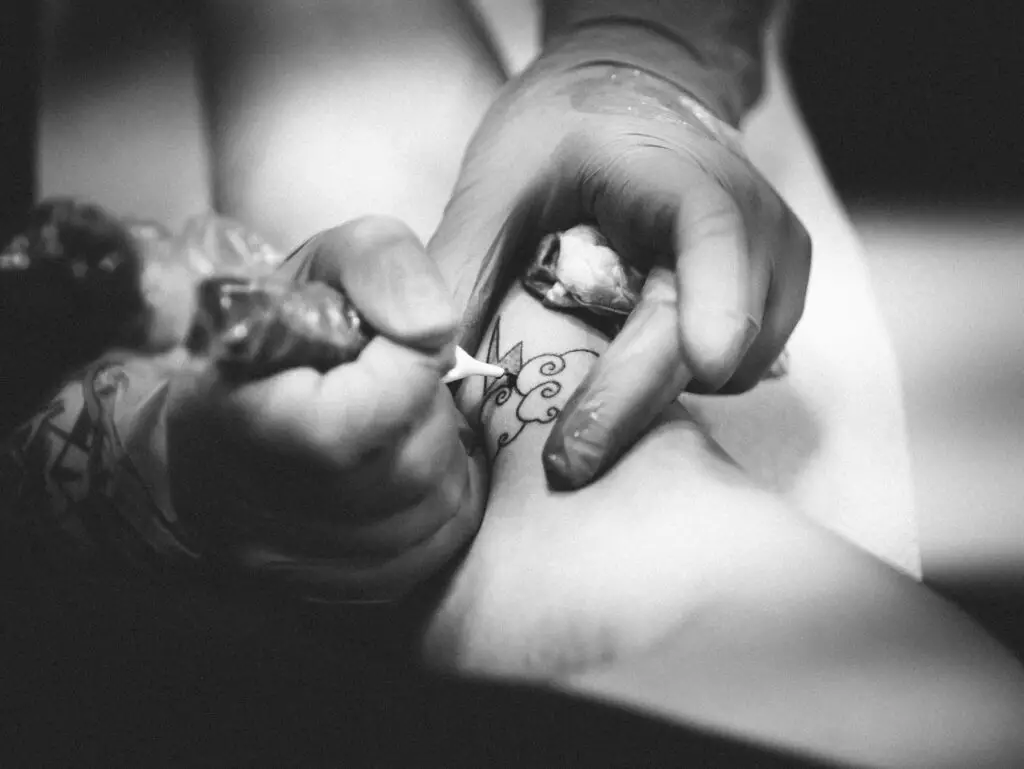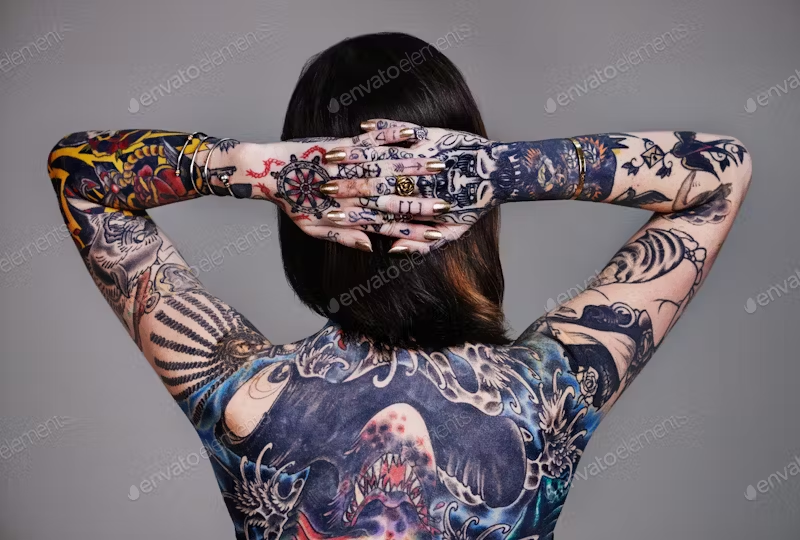Derm Shield vs. Saniderm. Tattoos, once a symbol of rebellion, have grown into an art form celebrated by many across the globe. With this rising acceptance comes the necessity for proper tattoo aftercare—a pivotal phase that determines not just the longevity of the tattoo, but also its vibrancy and clarity. Failing to take care of a fresh tattoo can result in infections, color fading, or other unwanted complications. Enter the modern age of tattoo aftercare, where traditional methods have made way for innovative products designed to maximize healing and protection. At the forefront of this evolution are two notable products: Derm Shield and Saniderm. Both have emerged as favorites among tattoo enthusiasts and professionals alike, each claiming to offer optimal care for fresh ink
Contents
Historical Context: The Evolution of Tattoo Aftercare
Tattoos have been a part of human culture for thousands of years, and so has the practice of tattoo aftercare. In ancient times, rudimentary aftercare might have involved using natural salves or balms made from herbs, oils, and other organic materials to keep the fresh tattoo clean and promote healing. As tattoos evolved through various cultures, so did the aftercare practices, often reflecting the available resources and prevailing medical knowledge of the times.
In more recent history, the 20th century saw the popularity of using products like petroleum jelly and antibiotic ointments as standard aftercare solutions. These products, while effective to some degree, were not without their flaws. They could sometimes smother the tattoo, leading to longer healing times or even causing adverse reactions on the sensitive, freshly inked skin.
Enter the 21st century, and the tattoo community began to witness a pivotal shift. As technology advanced and research grew, the industry leaned towards materials that were breathable, protective, and tailored for tattooed skin. This shift led to the rise of adhesive films as a prominent method for tattoo aftercare. Instead of slathering ointments, adhesive films provided a moist healing environment, reduced scabbing, and protected the tattoo from external contaminants.
Amidst this backdrop emerged brands like Derm Shield and Saniderm, capitalizing on the benefits of adhesive films. These products championed the advantages of a more modern approach to tattoo aftercare, combining the benefits of protection and optimal healing conditions

Purpose & Primary Function: Derm Shield vs. Saniderm
At the core of the tattoo aftercare evolution lies the main objective: to optimize healing while ensuring that the tattoo remains vibrant and free from complications. Both Derm Shield and Saniderm, despite their brand differences, share this foundational goal. So, what are the primary functions of these two prominent products?
To start, both Derm Shield and Saniderm are designed as adhesive films that closely adhere to the skin, covering the fresh tattoo. This ensures that the newly inked area is shielded from external factors. Whether it’s the daily dust from urban settings, potential allergens in the environment, or even the casual accidental touch, these adhesive films act as the first line of defense, preventing any unwanted interactions.
The protective barrier offers several tangible benefits:
- Infection Prevention: By blocking out dirt, bacteria, and other contaminants, the risk of infections is substantially reduced.
- Optimized Healing Environment: The barrier maintains a moist environment, which is known to expedite the natural healing process of the skin. This can lead to reduced scabbing and peeling compared to traditional aftercare methods.
- Reduction in External Irritants: Activities like wearing clothes can cause friction on the tattooed area. The protective film ensures that such interactions don’t directly impact the tattoo, hence reducing potential irritation.
However, it’s not just about safeguarding against external factors. The barrier also plays a crucial role in retaining the skin’s natural moisture and the ink’s vibrancy, ensuring that the tattoo remains as vivid as the day it was etched.
Material and Design: Derm Shield vs. Saniderm
In the realm of tattoo aftercare, the material and design of products play a pivotal role, particularly when the goal is to offer optimal protection while ensuring the tattoo heals beautifully. Both Derm Shield and Saniderm have harnessed the advantages of transparent adhesive film, but what does this entail, and how do the two brands compare?
Transparent Adhesive Film: At the heart of both products lies the transparent adhesive film. This material, often made from polyurethane or similar derivatives, is designed to be semi-permeable. This means it allows the skin to breathe (letting oxygen in) while retaining essential moisture, ensuring that the healing environment remains optimal. The transparency of the film serves a dual purpose: it allows the wearer to monitor the tattoo’s healing progress without the need for constant removal and reapplication, and it also showcases the tattoo, allowing its vibrancy to shine through even during the healing phase.
Differences and Similarities:
- Similarity – Breathability: Both Derm Shield and Saniderm pride themselves on providing a breathable barrier. This is essential as it ensures that while contaminants are kept out, the skin isn’t suffocated and can undergo its natural healing process.
- Similarity – Waterproof Nature: Given that both products are designed for extended wear (typically a few days), they are both waterproof. This design aspect allows users to shower without worry, ensuring that the tattoo remains protected from direct water streams, which can be harsh on fresh ink.
- Potential Differences: While the core material and the design intent are similar, there might be slight variations in the adhesive’s strength, the film’s thickness, or even the overall durability between Derm Shield and Saniderm. These nuances are often subtle and might be more noticeable to some users based on individual experiences.
- Packaging and Sizes: While this leans more towards usability than material, both brands may offer different sizes or shapes catering to various tattoo dimensions and body placements.
Their commitment to using transparent adhesive film underscores the industry’s shift towards materials that prioritize both protection and visibility. However, as with all products, slight variations in material quality or adhesive strength might sway individual preferences one way or another.
Application Process: Derm Shield vs. Saniderm
The effectiveness of a tattoo aftercare product isn’t just about the material or design but also how it’s applied. Both Derm Shield and Saniderm come with their guidelines, and while the fundamental process is similar, there could be nuances that set them apart. Let’s delve into the step-by-step application process and any recommended duration differences.

Step-by-step Application Guide:
- Cleanse the Area: Before applying either Derm Shield or Saniderm, it’s imperative to cleanse the tattooed area gently. Use lukewarm water and a mild, fragrance-free soap, ensuring all residues of blood or ink are washed away. Pat dry with a clean, lint-free cloth or paper towel.
- Cutting the Film (if necessary): Depending on the tattoo size and the sheet’s size, you might need to cut the film to fit the tattooed area. Ensure that there’s at least an inch of extra space around the tattoo for optimal adherence to the skin.
- Peel and Apply: Both films generally have a clear backing that needs to be peeled off. Once removed, gently place the adhesive side onto the tattoo, smoothing out any bubbles or wrinkles.
- Seal Edges: Ensure that the film’s edges are sealed properly to prevent any water or contaminants from seeping underneath during showers or regular activities.
- Removal & Reapplication: Typically, the first film is left on for a shorter duration (24-48 hours) to account for the initial weeping phase of a fresh tattoo. After this period, it’s recommended to remove the film, cleanse the area again, and apply a second piece of film. This second application can be left on for several days, sometimes up to a week, depending on the tattoo’s healing progression and the product’s guidelines.
Differences or Similarities in Recommended Duration:
- Initial Application: Both Derm Shield and Saniderm recommend that the first application stays on during the initial healing phase, typically 24-48 hours. This is when a tattoo might exude plasma, ink, and blood.
- Subsequent Applications: While both brands endorse longer durations for subsequent applications, the exact time can vary. Saniderm often suggests 3-5 days, whereas Derm Shield might recommend up to a week. It’s essential to monitor the tattoo and replace the film if it becomes overly saturated or if there’s any sign of irritation.
- Total Duration: Overall, both products emphasize that listening to your body and observing the tattoo’s healing progression is crucial. While product guidelines are helpful, individual healing rates and experiences can vary, and some might need to wear the film longer or shorter than others.
Key Benefits: Derm Shield vs. Saniderm
In the vast landscape of tattoo aftercare, the adhesive film method, as championed by brands like Derm Shield and Saniderm, stands out due to the numerous benefits it offers. Understanding these benefits is essential to making an informed choice. So, let’s explore the primary advantages these products promise and any differences that may emerge.
Main Benefits Both Products Promise:
- Protective Barrier: Both Derm Shield and Saniderm provide an immediate shield against external contaminants, such as dirt, dust, bacteria, and even potential allergens, significantly reducing the risk of infections.
- Optimal Healing Environment: By sealing in moisture while allowing the skin to breathe, these films create a moist healing environment. This promotes faster skin regeneration, leading to quicker healing times.
- Reduced Scabbing and Peeling: A moist environment also means reduced chances of the tattooed area drying out. As a result, users often report less scabbing and peeling compared to traditional aftercare methods.
- Waterproof Protection: Daily activities like showering become stress-free. The waterproof nature of both products ensures that the tattoo remains protected from direct water exposure, which can be harsh on fresh ink.
- Less Ink Loss: By protecting the tattoo from external friction and other irritants, there’s often a noticeable reduction in ink loss or color fade, ensuring the tattoo heals as vibrant as intended.
- Visibility and Monitoring: The transparent nature of the film ensures that individuals can easily monitor their tattoo’s healing process without the need for constant removal and reapplication, as might be required with bandages or gauze.
Differing Benefits Between Derm Shield and Saniderm:
When placed head-to-head, Derm Shield and Saniderm share most of their key benefits due to the similarity in their design and purpose. However, there might be slight variations in user experiences based on:
- Adhesive Strength: Some users might find one product to adhere more robustly than the other, which can be beneficial for those who are more active or sweat more frequently.
- Sensitivity: While rare, some individuals might react differently to one product over the other based on slight variations in the adhesive or material composition.
- Size and Packaging Options: One brand might offer a more extensive range of sizes or shapes, catering to various tattoo dimensions and body placements more effectively than the other.
- Environmental and Ethical Considerations: If either brand engages in more sustainable manufacturing processes or other ethically-driven initiatives, this might be viewed as an additional benefit for eco-conscious consumers.
Conclusion
Navigating the vast realm of tattoo aftercare, we’ve journeyed through the historical progression of treatment methods, leading us to the contemporary era where adhesive films reign supreme. Central to this modern approach are two noteworthy brands: Derm Shield and Saniderm. Their shared goal? To optimize the healing of fresh tattoos while ensuring longevity and vibrancy.
Both products, crafted from transparent adhesive films, offer robust protection against contaminants and ensure an optimal healing environment. Their design prioritizes both the physical protection of the tattoo and the user’s ability to monitor the healing process, an intersection of function and convenience. While they both champion reduced scabbing, quicker healing times, and minimized ink loss, nuances in adhesive strength, sensitivity, and product range might tilt preference towards one brand over the other for some individuals.
However, it’s essential to remember that tattoo aftercare is as personal as the tattoos themselves. What works phenomenally for one person might not yield the same results for another
In wrapping up this exploration, the overarching advice remains unchanged: personal preference plays a pivotal role, but always prioritize consultation with tattoo professionals. Their experience and understanding of skin types, tattoo styles, and healing trajectories can offer invaluable insights, guiding you to the best aftercare choice for your unique piece of art.





